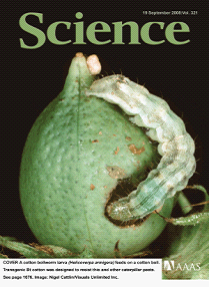分享到
Bt. Cotton Offers A New Approach in Improving Agricultural Ecosystem

Research team lead by Professor WU Kong-ming from the Institute of Plant Protection, CAAS recently published their latest research achievement “Suppression of Cotton Bollworm in Multiple Crops in China in Areas with Bt Toxin-Containing Cotton” on Science magazine (September 19 2008: vol. 321) . This is the first paper published on this magazine with CAAS as the first writer. According to Wu, analysis of the population dynamics of H. armigera from 1992 to 2007 in China indicated that a marked decrease in regional outbreaks of this pest in multiple crops was associated with the planting of Bt cotton. The study area included six provinces in northern China with an annual total of 3 million hectares of cotton and 22 million hectares of other crops (corn, peanuts, soybeans, and vegetables) grown by more than 10 million resource-poor farmers. Data suggest that Bt cotton not only controls H. armigera on transgenic cotton designed to resist this pest but also may reduce its presence on other host crops and may decrease the need for insecticide sprays in general. This is exciting news for exploring new approach to pest control and crop production increase.
Science magazine and its publisher the “American Association for the Advancement of Science” (AAAS) co-hosted a press conference in Beijing with CAAS to declare this achievement. This is also the first Press Conference held in China at which AAAS gave high credit to its cover story.
Background: Bacillus thuringiensis (Bt) is a spore-forming bacterium, which produces crystal proteins that are toxic to many species of insects. Bt cotton plants have been modified with short sequences of Bt genes to express the crystal proteins that the bacterium produces, so that the plants themselves produce the insecticidal proteins. In 1992, bollworm has eaten off 30% of the annual cotton production and the overuse of pesticide lead to a series of issues, such as insect resistance and resurgence, decrease of farmer's income, pesticide residue and environment pollution. By several year studies, Bt cotton was bred and its planting in China has the advantages of reducing the use of chemical insecticides for control cotton bollworm and cotton aphid, which would benefit for decreasing environmental pollution and related costs from the insect control and increase the potential for natural and biological control of cotton insect pests. So far, 4,210 hectare crops with Bt are planted, accounting for 37% of all the genetically modified plants. In 1997, the Chinese government officially approved the commercialization of Bt cotton. By 2007, China has 3.8 million hectares of Bt cotton planted.
Latest News
-
 Apr 18, 2024Opening Ceremony of the Training Workshop on Wheat Head Scab Resistance Breeding and Pest Control in Africa Held in CAAS
Apr 18, 2024Opening Ceremony of the Training Workshop on Wheat Head Scab Resistance Breeding and Pest Control in Africa Held in CAAS -
 Apr 03, 2024IPPCAAS Co-organized the Training Workshop on Management and Application of Biopesticides in Nepal
Apr 03, 2024IPPCAAS Co-organized the Training Workshop on Management and Application of Biopesticides in Nepal -
 Mar 28, 2024Delegation from the School of Agriculture and Food Science of University College Dublin, Ireland Visit to IAS, CAAS
Mar 28, 2024Delegation from the School of Agriculture and Food Science of University College Dublin, Ireland Visit to IAS, CAAS -
 Mar 25, 2024Director of World Food Prize Foundation visited GSCAAS
Mar 25, 2024Director of World Food Prize Foundation visited GSCAAS -
 Mar 20, 2024Institute of Crop Sciences (ICS) and Syngenta Group Global Seeds Advance Collaborative Research in the Seed Industry
Mar 20, 2024Institute of Crop Sciences (ICS) and Syngenta Group Global Seeds Advance Collaborative Research in the Seed Industry
